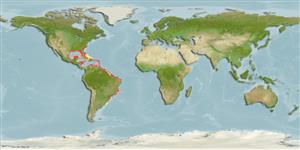Common names from other countries
Environment: milieu / climate zone / depth range / distribution range
Οικολογία
βενθοπελαγικό; Υφάλμυρο; εύρος βάθους 0 - 75 m (Ref. 367). Tropical, preferred 26°C (Ref. 107945); 35°N - 38°S, 98°W - 34°W
Western Atlantic: USA to Argentina.
Length at first maturity / Μέγεθος / Βάρος / Age
Maturity: Lm 59.5 range ? - ? cm Max length : 13.9 cm CW αρσενικό/απροσδιόριστο; (Ref. 367); 11.3 cm CW (female); μεγ. αναφερόμενη ηλικία: 2.50 έτη (Ref. 85497)
Carapace slightly more than twice as broad as long; 9 teeth on arched anterolateral margin 9outer orbital tooth and strong lateral spine included) progressively more acuminate laterally; outer pair of frontal teeth (excluding inner orbital angles) prominent but inner pair small. Much of convex dorsal surface lightly granulate, most prominently so on anterior and elevated areas and in transverse lines; central trapezoidal (metagastric) area short and wide (anterior width about 2 to 2.5 times, posterior width about 1.5 times length). Pincers dissimilar, ridged longitudinally; fifth legs flattened in form of paddles. Male with T-shaped abdomen reaching slightly beyond suture between thoracic sternites 4 and 5; first pleopods reaching beyond midpoint of thoracic 6, nearly straight distally except for merabranous tips usually bent ventrolaterally, armed with scattered, minute, mainly dorsal spinules and 2 to 4 subterminal, exceedingly slender, elongate sternomesial spinules. Color: variably olive to greyish blue dorsally, spines olive to indigo and white-tipped; pincers with variable blue to purple on upper and inner surfaces, olive to blue externally; legs predominantly dark blue to azure or greenish, underparts white. Some individuals are duller and some have a reticulate pinkish blue cast on the upper surface of chelipeds.
Minimum carapace width: 3 cm (Ref. 93549). Maximum length of female from Ref. 85497.
Life cycle and mating behavior
Γεννητική Ωρίμανση | Αναπαραγωγή | Γεννοβολία | Αβγά | Γονιμότητα | Προνύμφες
Members of the order Decapoda are mostly gonochoric. Mating behavior: Precopulatory courtship ritual is common (through olfactory and tactile cues); usually indirect sperm transfer.
Tavares, M. 2003. (Ref. 367)
IUCN Red List Status (Ref. 130435: Version 2024-1)
CITES status (Ref. 108899)
Not Evaluated
Not Evaluated
Human uses
αλιεία: Εμπορικό(ά)
FAO - αλιεία: landings | FishSource | Η θάλασσα γύρω μας
Εργαλεία
Διαδικτυακές πηγές
Estimates based on models
Preferred temperature
(Ref.
115969): 23.3 - 28, mean 26.1 (based on 500 cells).
Ελαστικότητα
Υψηλό, ελάχιστος χρόνος για διπλασιασμό πληθυσμού < 15 μήνες (K=1.83; tmax=2.5).
Vulnerability
Low vulnerability (16 of 100).
